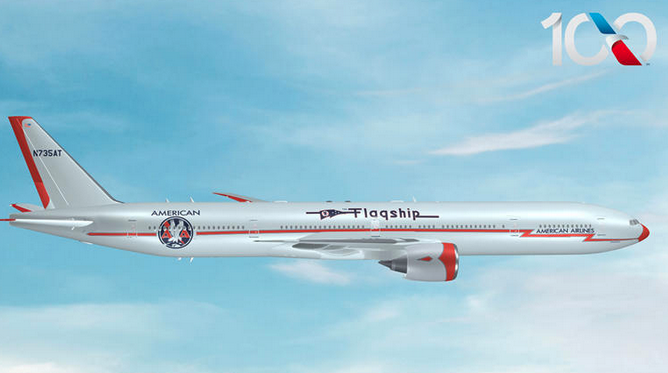American Airlines Unveils Retro Flagship Livery Ahead of 100th Anniversary

American Airlines is celebrating its upcoming 100th anniversary with a nostalgic yet modern tribute to its storied past. The Dallas-based carrier has revealed a special retro-inspired Flagship livery that will debut in November on one of its Boeing 777-300ER aircraft. The design reimagines one of American’s earliest liveries, blending vintage charm with contemporary style.
The airline selected the Boeing 777-300ER for this historic paint scheme because the model will soon undergo a major interior upgrade. American plans to introduce its new Flagship Suite business class product across its 777-300ER fleet, offering 70 suites in the forward cabin along with 44 Premium Economy seats. These enhancements are part of the airline’s broader effort to elevate the passenger experience and redefine luxury travel across its long-haul network.
“American has thoughtfully chosen a design that evokes our rich history while looking ahead to our next 100 years,” said Ron DeFeo, American’s Chief Communications Officer. “‘Flagship’ has always represented our premium travel experience, and this new livery is a powerful way to honor that legacy while embracing the future.”
The aircraft’s retro design pays homage to the airline’s heritage with several historic elements, including its signature “Silver Eagle” paint, the orange lightning bolt logo first introduced 90 years ago, and an earlier version of the iconic eagle emblem.
The specially painted aircraft, registered as N735AT, is expected to operate primarily on international routes from Miami (MIA) and Charlotte (CLT), including flights to São Paulo (GRU) and London Heathrow (LHR). Aviation enthusiasts eager to experience this unique aircraft can track its schedule by searching for its registration number.
“It was the first airplane that could make money just by hauling passengers.” — C.R. Smith, longtime President of American Airlines, speaking about the Douglas DC-3. Excerpt From: Jennifer Coutts Clay, the author of “JETLINER CABINS: Evolution & Innovation.”
American Airlines Fleet in the 1920s
About 100 years ago, American Airlines’ earliest predecessor companies operated small, single-engine propeller aircraft, very different from today’s long-haul jets. Here’s a quick historical overview:
When the companies that eventually became American Airlines began flying mail and passengers in the 1920s, they used aircraft such as:
- Curtiss JN-4 “Jenny” – a biplane widely used for U.S. Air Mail service and early passenger flights.
- Ford Trimotor – introduced in the late 1920s, it became one of American’s first multi-engine passenger aircraft. It could carry up to 10 passengers and was nicknamed the “Tin Goose.”
- Douglas DC-2 and DC-3 (1930s) – by the mid-1930s, these aircraft revolutionized American’s operations, offering reliable cross-country passenger service. Early American Airlines “Flagship” DC-3s generally seated 21 passengers in luxury sleeper or day-seat layouts. The DC-3 in particular became the backbone of American’s fleet and a key aircraft in the rise of modern commercial aviation.
So, around 1926, the year American traces as its founding, its operations involved light single-engine mail planes like the Curtiss JN-4 and early Stinson and Waco models. Within a decade, the airline transitioned to the Ford Trimotor, and later the Douglas DC-3, which established American Airlines as one of the pioneers of modern passenger air travel.
As American Airlines approaches its centennial year in 2026, marking a century since its first passenger flight in 1926, the new retro Flagship livery serves as a reminder of the carrier’s deep roots and forward-looking innovation—celebrating its evolution from aviation pioneer to global leader in premium air travel.
Related News: https://airguide.info/?s=American+Airlines
Sources: AirGuide Business airguide.info, bing.com, aa.com &
Excerpts From: Jennifer Coutts Clay, the author of “JETLINER CABINS: Evolution & Innovation.”
